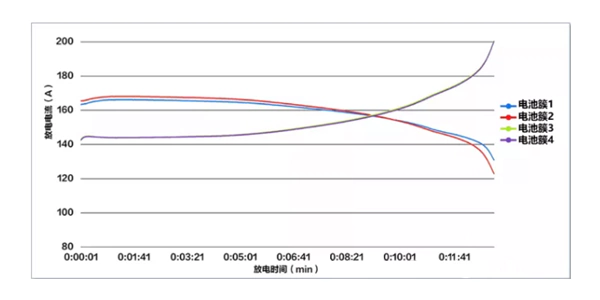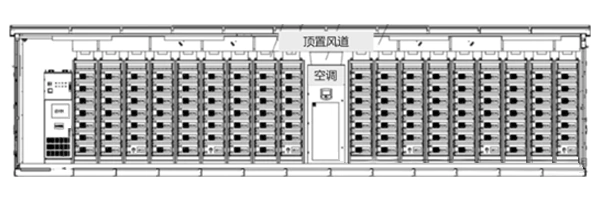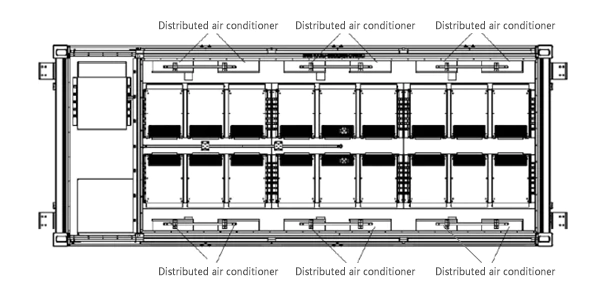에너지 저장의 불일치 배터리는 주로 배터리와 같은 매개변수의 불일치를 나타냅니다. 용량, 내부저항, 온도. 우리의 일상 경험은 다음과 같습니다 두 개의 건전지를 양극과 음극 방향으로 연결하면 손전등이 켜지는데 우리는 그렇지 않아요 일관성을 고려하십시오. 그러나 배터리를 대규모로 사용하게 되면 에너지 저장 시스템의 상황은 그리 간단하지 않습니다. 일관성이 없을 때 배터리를 직렬 및 병렬로 사용하면 다음과 같은 문제가 발생합니다.
1. 사용 가능한 용량 손실
에너지저장시스템에 있어서 배터리 셀은 (즉, 배터리 셀)을 직렬로 연결하여 배터리 팩을 형성하고, 배터리 팩은 직렬로 연결되어 배터리 클러스터를 형성합니다. 다수의 배터리 클러스터는 동일한 DC 버스에 병렬로 직접 연결됩니다. 그만큼 셀 불일치로 인해 사용 가능한 용량이 손실되는 이유는 다음과 같습니다. 직렬 불일치와 병렬 불일치.
(1) 배터리팩 시리즈의 분실 불일치:
차이 등의 불일치로 인해 배터리 셀 자체와 배터리 간의 온도 차이 팩마다 각 배터리 팩의 SOC(남은 전력)가 다릅니다. 처럼 하나의 배터리 팩이 가득 차거나 비어 있는 한 클러스터의 모든 배터리 팩은 충전 및 방전을 중지합니다.

그림 1. 배터리 불일치로 인해 시리즈 용량 불일치가 발생함
(2) 불일치 손실 배터리 클러스터 병렬 연결:
배터리 팩을 직접 넣은 후 병렬로 연결되어 배터리 클러스터를 형성하고 각 배터리의 전압 클러스터는 균형을 유지해야 합니다. 배터리 클러스터가 더 작을 때 내부 저항이 완전히 충전되거나 방전되면 다른 배터리 클러스터 충전 및 방전을 중지해야 하므로 배터리 클러스터가 작동하지 않습니다. 완전 충전 또는 완전 방전.

그림 2 동안 전류 차이 여러 배터리 클러스터를 병렬로 방전
게다가 내부가 작기 때문에 각 클러스터 간의 전압 차이가 있더라도 배터리 저항 불일치로 인한 것은 단지 몇 볼트, 사이의 고르지 못한 전류입니다. 클러스터는 매우 클 것입니다. 발전소의 측정 데이터에서 볼 수 있듯이 아래 표에서 충전 전류 차이는 75A에 도달합니다(편차 이론 평균값과 비교하면 42%입니다. 편차 전류는 일부 배터리 클러스터에서는 과충전 및 과방전이 발생합니다. 크게 충전 및 방전 효율, 배터리 수명, 심지어 원인까지 영향을 미칩니다. 심각한 안전사고.
|
|
충전/방전 |
전압 |
현재 |
SOC |
|
첫 번째 클러스터 |
요금 |
793.2V |
-197.8A |
66 |
|
두 번째 클러스터 |
요금 |
795.3V |
-126.6A |
77 |
|
세 번째 클러스터 |
요금 |
792.8V |
-201.6A |
66 |
표 1의 측정 데이터 발전소
2. 에너지 수명 단축 저장 시스템
온도가 가장 중요한 요소입니다. 에너지 저장 장치의 수명에 영향을 미칩니다. 내부 온도가 높아지면 에너지 저장 시스템의 수명은 15°C 상승합니다. 에너지 저장량이 절반 이상 단축됩니다. 리튬이온 배터리는 충전과 방전 과정에서 많은 열이 발생합니다. 단일 셀의 내부 저항이 일관되지 않기 때문에 에너지 저장 시스템 내부의 온도 분포는 고르지 않습니다. 배터리 노후화 및 감쇠율이 증가하고 궁극적으로 수명이 단축됩니다. 에너지 저장 시스템이 단축됩니다.
온도를 알 수 있다. 에너지 저장 시스템에서 배터리의 불일치는 중요합니다. 에너지 저장 시스템의 성능에 영향을 미치는 요소. 줄일 것이다 에너지 저장 시스템의 가용 용량은 사이클 수명을 단축시킵니다. 에너지저장시스템에 영향을 미치고 심지어 안전상의 위험을 초래할 수도 있습니다.
대처 방법 에너지 저장 배터리의 불일치?
배터리 셀의 불일치는 생산 과정에서 형성되고 사용 중에 깊어집니다. 약할수록 동일한 배터리 팩에 들어 있는 배터리 셀일수록 약해지고 약해집니다. 그렇습니다. 하지만 완전히 일관된 배터리 셀은 없더라도, 디지털 기술, 전력전자 기술 융합 가능 에너지 저장 기술 및 전력 전자 장치의 제어 가능성을 사용합니다. 리튬 배터리 불일치로 인한 영향을 최소화하는 기술입니다. 응답으로 이전 글에서 분석한 불일치로 인해 발생하는 문제에 대해, 시장의 일부 제조업체는 스트링 에너지 저장 시스템을 출시했습니다. 세련된 에너지 관리와 분산형의 특성을 지닌 온도 조절 및 증상 치료에 사용할 수 있습니다.
(1) 관리를 정교화한다. 사용 가능한 용량 증가
기존 PCS에 비해 1,000~2,000개 이상의 셀을 관리하는 스트링에너지 저장시스템 셀 관리 정확도를 12개 이상, 즉 약 100개로 향상시킵니다. 배 더 높습니다. 배터리 팩 간의 시리즈 불일치를 고려하여 옵티마이저는 별도의 충전 및 방전 관리를 달성하도록 설계되었습니다. 각 배터리 팩. 배터리 팩이 설정된 임계값에 도달하면 배터리가 팩은 바이패스되고 다른 배터리 팩은 계속 충전 및 방전될 수 있습니다. 서로 영향을 주지 않고 배터리 용량을 최대한 활용합니다.
동시에 각 배터리 클러스터는 배터리의 영향을 피하기 위해 지능형 클러스터 컨트롤러가 장착되어 있습니다. 직접 병렬 연결로 인한 불일치로 인해 충전 및 각 클러스터의 방전 전류를 오차로 정확하게 제어할 수 있습니다. 1% 미만. 이를 통해 클러스터 간의 불일치를 방지하고 실제로 배터리 클러스터 간 독립적인 충전 및 방전 관리, 순환의 발생을 없애고, 용량을 더욱 향상시킵니다. 시스템의 안전성.
(2) 분포온도 에너지저장시스템의 수명연장을 위한 제어
전통적인 에너지 저장 용기는 다음과 같습니다. 1-2개의 중앙 집중식 에어컨을 갖추고 종방향 공기 덕트를 사용합니다. 열 방출을 위해. 공기 덕트의 길이는 약 6 미터에서 12 미터입니다. 미터. 긴 방열 채널로 인해 온도 일관성이 유지됩니다. 각 배터리 팩과 배터리 클러스터의 성능은 보장되지 않습니다.

그림 3 전통 중앙 집중식 방열 구조
스트링 에너지 저장장치는 클러스터 수준을 사용합니다. 대신 분산 에어컨을 사용하여 분산 열 방출 중앙 집중식 에어컨. 각 배터리 클러스터는 열을 발산할 수 있습니다. 독립적이고 균일하며 공기 덕트 길이는 1m 미만입니다. 방열 효율을 크게 향상시키고 온도를 피합니다. 물리적 위치로 인한 차이. 동시에 배터리 팩 나무 모양의 바이오닉 특허 방열 덕트를 교묘하게 사용하여 온도를 조절합니다. 각 배터리 셀 덕트의 길이와 거리를 조절하여 냉각량이 각 배터리 셀을 통과하는 전류는 가능한 일관되게 전달되어 각 전지 셀 표면의 온도 불일치.

그림 4 분산 방열구조도
배터리 불일치가 근본 원인입니다. 현재 에너지 저장 시스템에는 많은 문제가 있습니다. 하지만 화학물질로 인해 배터리의 특성과 사용 환경의 영향, 배터리 불일치는 근절하기 어렵습니다. 끈 에너지 저장 시스템은 배터리 일관성에 대한 시스템 요구 사항을 크게 약화시킵니다. 전력 전자공학과 디지털 기술의 제어 가능성을 통해 에너지 저장 시스템의 가용 용량을 크게 늘릴 수 있으며, 시스템 안전성을 향상시킵니다.